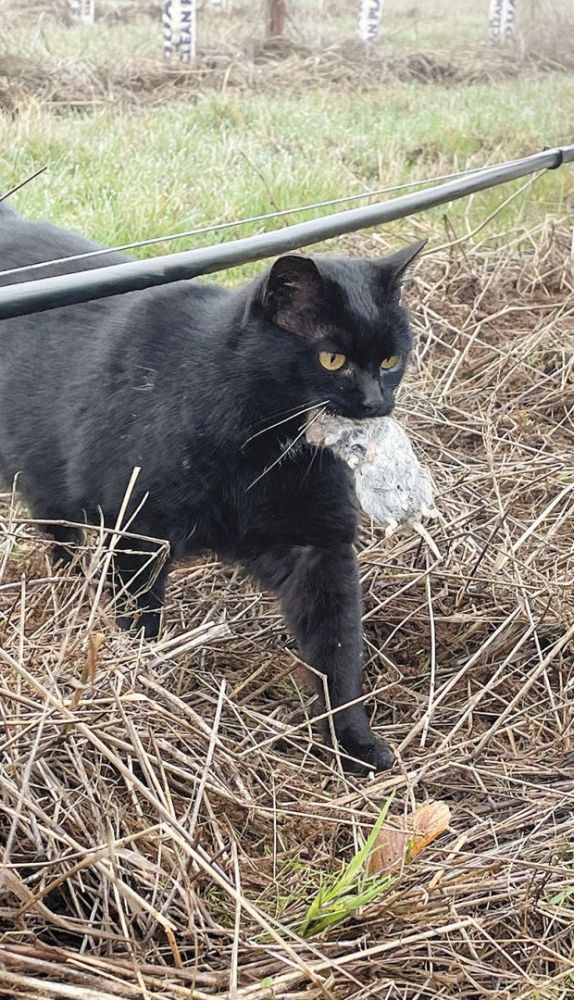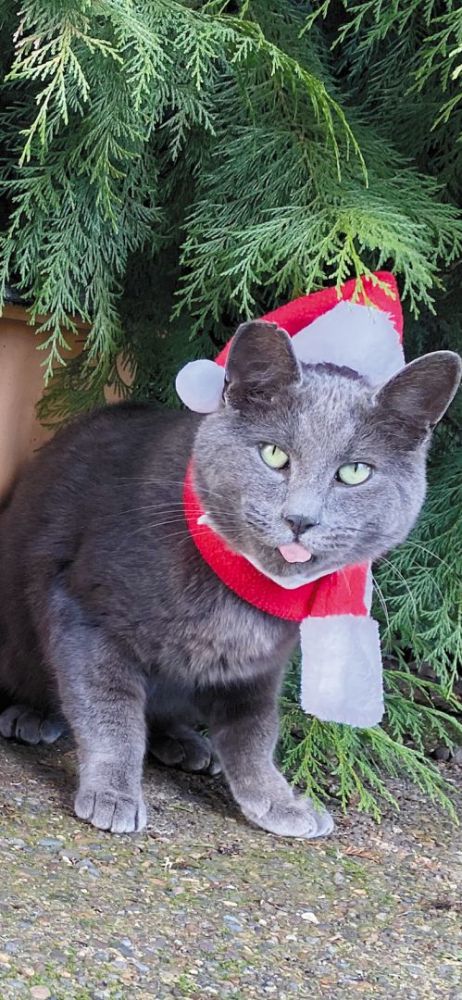On the Prowl
Wineries and vineyards provide feral cats with a second chance





By Greg Norton
Jaws, the resident cat at Left Coast Estate in Rickreall, has his own Google review page (search “Jaws the winery cat”). One admirer even wrote:
“Came for the wine, stayed for the Jaws. Majestic good boi knows how to chill nearby, while gladly accepting scritches, pats, and any other forms of love. (five stars)”
This furry denizen of the tasting room is the most famous of the once-feral cats currently living and working at Oregon wineries. Far more than pets or mascots, they represent an inventive solution to two pressing issues: the growing population of feral cats and costly rodent damage to vineyard crops and property.
Two Problems
While exact numbers are elusive, the U.S. feral cat population is estimated to be in the tens of millions. These free-ranging, ownerless cats live outdoors in colonies near food sources. Often with little or no human contact, they may act aggressively toward people. Studies show their hunting instincts ravage native birds, mammals, reptiles and amphibians. Feral cats can also spread disease along with parasites to domestic animals, wildlife and humans. Life for these cats is typically hard and short.
The other problem: vineyard crop yield losses caused by bird and rodent damage can approach 40 percent, according to a 2012 United States Department of Agriculture study. Mice and rats also invade wine production facilities, damaging wiring and equipment while introducing contamination. Here, cats’ hunting instincts prove invaluable.
“I used to have to put traps and poison and stuff around,” said Dan Warnshuis, owner and winemaker at Utopia Vineyard & Winery in Newberg. Over two years ago, Utopia adopted two black feral cats, Midnight and Noir. Warnshuis relies on his two springer spaniels for vineyard gopher patrol, but the cats make mice scarce in the winery building.
“The cats have been a godsend,” he says.
Farther Afield
At other vineyards, cats hunt outdoors between the rows, eradicating mice and voles. Voles resemble mice; they feed on roots and at the base of vine trunks. Their damage can extend into the canopy when they chew shoots and grape stems.
“I joke that I’d like to have an army of cats,” said Meghan Olivier, owner of St. Merry Vineyard in Dallas. Biscuit and Muffin, two resident cats, shelter in a barn— now free of rodents— while patrolling a large perimeter of the property. “They mostly hunts the voles,” Olivier reports, “we do have a lot of those, like many nearby vineyards.”
Both cats share part of a larger ecosystem that includes pigs, geese, and chickens— all contributing to the vineyard’s health.
Meow Village
The cats at Left Coast, Utopia and St. Merry were adopted from Meow Village, a nonprofit feral cat rescue organization in Aurora. Its “Barn Livin’ Is the Life for Me” program places cats in stables, sheds, shops, barns— and wineries. Other participating vineyards include Arborbrook Vineyards, Blakeslee Vineyard Estate and Chehalem Winery.
The organization began in 2007 to care for a local feral colony and now works in the state's northwestern corner. Their Barn Livin’ program supplies adoptable healthy, spayed or neutered and vaccinated felines where they will spend most of their lives outdoors. Large cages contain the cats for the first four or five weeks in a barn or other shelter while they acclimate to their new surroundings. Volunteers continue to assist property owners to ensure a successful placement. Meow Village maintains a list of hundreds of feral cats awaiting adoption, according to volunteer Leann Garrison.
Since 2018, Meow Village has placed several cats at Left Coast. “All of the cats helped as mousers,” Left Coast’s CEO Taylor Pfaff said, “but it was Jaws that quickly became our li’l mascot.”
Jaws headlined “Jaws-a-palooza,” a fundraiser for Meow Village held this summer at the winery. Occasional wine and kitten events at area wine bars and tasting rooms also raise awareness along with additional funds.
Another Kind Of Rescue
A dusty gravel road leads past countless rows of vines to Willamette Valley Vineyards' Tualatin Estate tasting room. Vast tracts of agricultural land encircle the 171-acre vineyard near Forest Grove. Lurking cats prowl and dart everywhere.
Unowned felines amass here on their own or, sadly, are dumped by humans. The winery barn supplies shelter for a colony of several dozen at a time. The tamer ones find their way to the tasting room to be adored by visitors, but the majority avoid people.
All the vineyard staff members share care for the mousers– occasionally in unintended ways. Once, a vineyard steward brought a second-hand mattress to work, intending to give it to a co-worker. It was left in the barn during the day’s work; by the time the crew returned from the vineyard, it had become a “cattress.”
Tasting room lead Ava Blake has taken a particular interest in a friendly female colony member the team christened Sweet Hannah after the winery’s late-harvest dessert wine. Thus far, the cat has eluded all efforts to trap and spay her by veterinarian teams who come specifically to fix Sweet Hannah. While efforts to trap and spay the mom cat have been foiled, they’ll continue to try, Blake says. They got close last time until they found she was pregnant, or as Blake said—as big as a watermelon. Instead, Sweet Hannah has birthed several litters of kittens on the property.
“After she has a litter… she’ll bring them up on the [tasting room] deck for us to see,” reports Blake. There, the kittens are fed and socialized to be around people, including employees, longtime customers, and club members who may end up taking home a new pet along with a bottle of Pinot Noir.
Blake recalls a customer showing her a photo of a kitten rehomed from the tasting room a year and a half before, now a beloved family member. “It’s fun,” she said. “People become club members and also adopt kittens from here.”
A Creative Reciprocity
Oregon vineyards are recognized for sustainable farming practices, thus reducing chemicals and poisons. Winery cats play a small, but significant role in this effort, while helping to address the problems of feral cat overpopulation and rodent damage.
On occasion, a cat like Jaws becomes a star. Left Coast features him on T-shirts and other promotional items.
“Jaws’ fame grows greater by the day,” Pfaff said. “He’s our top wine sales cat.”
To learn more about Meow Village’s Barn Livin’ Program or to adopt, donate or volunteer, visit www.meowvillage.org.
Greg Norton is a freelance writer with a broad background in nonprofit communications and the arts. He studied journalistic writing through the UCLA Extension and has traveled to wine regions around the world. Greg is a Certified Specialist of Wine and received the Level II award from the Wine and Spirits Education Trust. When not writing about wine, he can be found pouring it in the tasting room at Campbell Lane Winery near West Linn. Read more by Greg at www.onthevine.blog.










